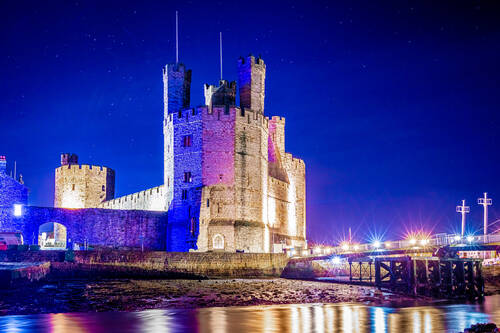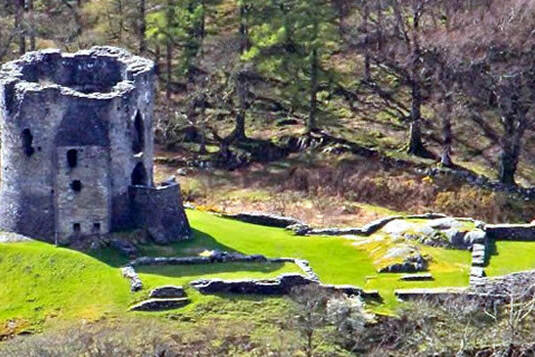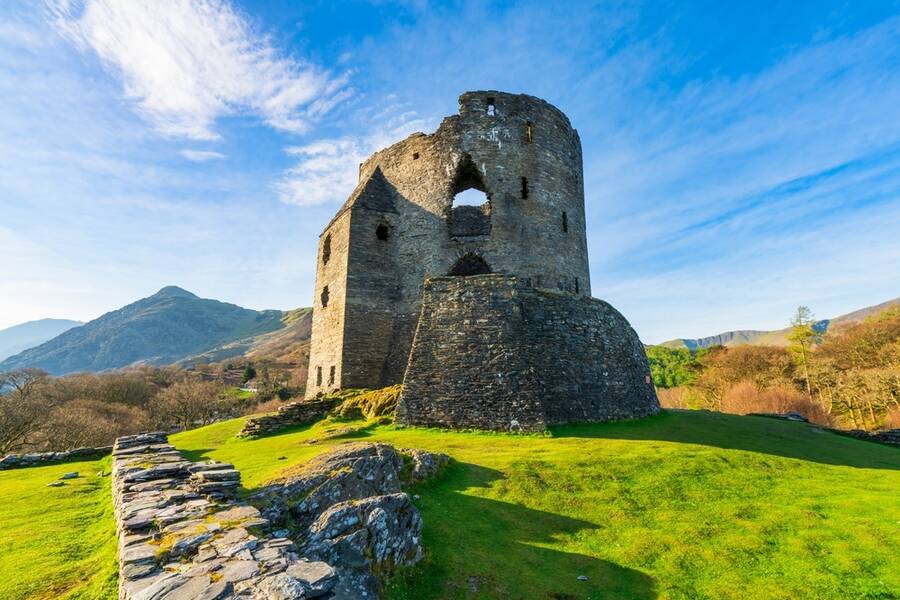Dolbadarn Castle: Your Guide to Llanberis’ Historical Landmark
Dolbadarn Castle is a 13th-century fortress nestled in the grounds of The Royal Victoria Hotel Llanberis, overlooking the twin lakes of Llyn Padarn and Llyn Peris. Though smaller than some of North Wales’s famous castles, this medieval landmark holds immense historical significance and offers breathtaking views of Eryri (Snowdonia).
Often overlooked by tourists rushing to the more well-known sites,Dolbadarn Castle is the perfect spot to explore the history of our local area. In this guide, we delve into the castle’s rich history, its importance to Llanberis, unique architectural features and practical tips for visitors – so you can make the most of your visit.
The History of Dolbadarn Castle
Dolbadarn Castle was built in the early 13th century by Llywelyn ap Iorwerth (Llywelyn the Great), the prince of Gwynedd. Its strategic location at the foot of the Llanberis Pass meant that even a small Welsh garrison could control movement through the valley, which was once the principal route into the kingdom of Gwynedd. In an era before Edward I’s infamous ring of Edwardian castles, Dolbadarn stood as a symbol of native Welsh power and ingenuity, guarding the mountain pass and the communities of Snowdonia.Over the years, the castle became entangled in the turbulent history of Welsh royalty. In the 1250s, Owain Goch, a rival claimant to the Welsh throne, was imprisoned by his brother in Dolbadarn’s tower for almost 20 years. This bleak chapter of fraternal feud highlights the castle’s role as both fortress and political prison.Dolbadarn eventually fell to English forces during King Edward I’s conquest of Wales – it was seized in the 1280s and subsequently stripped of timbers and materials (some timbers were even repurposed to build Caernarfon Castle). By the 14th century, the stronghold was largely abandoned, a silent witness to the end of independent Welsh rule.

Around 1400, the rebel prince Owain Glyndŵr is believed to have used Dolbadarn Castle to hold captured enemies during his uprising. Locals dubbed this episode “Dolbadarn’s last gasp” – a final, defiant footnote linking the ruin to the long fight for Welsh independence.
In the centuries that followed, artists and poets (even J.M.W. Turner painted it) found inspiration in Dolbadarn’s lonely dignity. Today, the ruins are protected by Cadw (Wales’s historic environment service) as a monument to the Welsh past and open for all to explore freely.
Dolbadarn Castle also weaves into local folklore. Llanberis is a land of legends, from child-stealing fairies to a child-eating witch. These myths, which we share in our Dolbadarn: Our Castle and Other Llanberis Legends journal, add an extra layer of mystery to the castle’s story.
Dolbadarn Castle’s Significant Location
Sitting in the grounds of our hotel above Llanberis village, Dolbadarn Castle boasts a location as dramatic as its history. In the past, this vantage point was of prime importance – the castle was the “solitary guardian” of the Llanberis Pass into the heart of Snowdonia. From its tower, you could watch over the route inland from Caernarfon, making sure no enemy armies slipped through unnoticed. This lofty oversight earned Dolbadarn a reputation as a small but mighty guard in the Welsh princes’ network of fortresses.Today, it translates into stunning panoramas of the landscape below. Visitors who climb to Dolbadarn’s perch are rewarded with sweeping views of the lakes, the slate-quarry distressed hillsides and the forests around Eryri National Park.The castle’s relatively modest size in no way diminishes its charm. In fact, its “overlooked” status means you might often find the ruins quiet and peaceful, perfect for slow-paced exploration.Read more about Dolbadarn Castle’s home in our Llanberis’ Journey Through Time journal.

Tips for Visiting Dolbadarn Castle
Visiting Dolbadarn Castle is like stepping back in time and the good news is that it’s very accessible. Here are some tips to make your visit smooth and enjoyable:
- Getting there: Dolbadarn Castle is situated at the edge of Llanberis village. If you’re staying at The Royal Victoria Hotel, you can simply stroll through the hotel’s grounds to reach the castle. Otherwise, there’s a car park (LL55 4TY) right across the road from the castle path. The site is well-signposted and the trail up is easy to find – just look for the information sign and gate near the main road.
- Path and terrain: The walk up to the castle takes about 10–15 minutes through a lovely, wooded hill path. It’s a moderate uphill walk on a dirt/rock trail. After rain, the path can be muddy and slippery, and it does get steeper as you approach the castle, so sturdy footwear is recommended. Take your time, especially if the weather is wet. There are a few benches along the way if you need a rest and to enjoy the view.
- Admission and timing: Great news – entry is free, and the castle is open all year round at all reasonable daylight hours. There are no tickets or gates, so you can wander in at your leisure. This also means there’s no official closing time in the evening, so you might catch a stunning sunset from the castle if you time it right. Early morning and late afternoon often provide the best light for photographs, with the lakes shimmering below and Eryri’s peaks in the background.
- Facilities and accessibility: Dolbadarn Castle is a ruin on a hill so there are no facilities on-site such as a visitor centre or toilets. However, Llanberis village is right next door with cafés and shops. If you’re a guest at the Royal Victoria Hotel, you have the added perk of nearby amenities (and perhaps a cosy spot to enjoy tea after your castle excursion!). The castle is also dog-friendly so feel free to bring your dog on a lead for the walk. Just watch young children closely, as there are sheer drops and uneven surfaces among the ruins.
- Experience the history: To fully appreciate Dolbadarn Castle, take a moment once you reach the top to read the information plaques that detail the castle’s history. Try to imagine the bustling courtyard as it was in the 13th century or stand inside the base of the tower and look up at the sky through the ruined roof. The panoramic views of Llyn Padarn, the village of Llanberis and Yr Wyddfa (Mount Snowdon) are picture-perfect on a clear day. And if you’re curious about more local history or the legends of the area, consider combining your castle visit with a trip to the Slate Museum or a ride on the Snowdon Mountain Railway for a day full of heritage and adventure.
Step into the Rich History of Wales at Dolbadarn Castle
We warmly invite you to come and explore Dolbadarn Castle on your next trip to Snowdonia. And when you do, why not make a weekend of it? The castle’s very own neighbour, The Royal Victoria Hotel, awaits you with cosy rooms and a storied charm of its own.
In fact, by staying with us, you’ll be immersing yourself in the rich history of the Royal Victoria Hotel Llanberis as well – a story that has been intertwined with Dolbadarn Castle for nearly two centuries. We look forward to hosting you and sharing the magic of Dolbadarn Castle and Llanberis. Happy exploring, or as we say in Wales, mwynhewch eich antur – enjoy your adventure!
